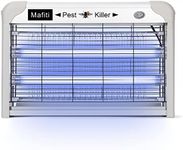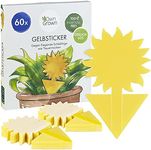Buying Guide for the Best Mosquito Zappers
Choosing the right mosquito zapper can make a significant difference in your comfort and health, especially during the warmer months when mosquitoes are most active. A mosquito zapper is a device designed to attract and kill mosquitoes and other flying insects. To find the best fit for you, it's important to understand the key specifications and how they align with your needs. Here are the main factors to consider when selecting a mosquito zapper.Coverage AreaCoverage area refers to the amount of space a mosquito zapper can effectively protect. This is important because it determines how large of an area the device can keep mosquito-free. Coverage areas can range from small, personal spaces to large outdoor areas. If you need a zapper for a small room or a patio, a device with a coverage area of up to 500 square feet might be sufficient. For larger yards or outdoor events, look for zappers that cover 1,000 square feet or more. Choose a zapper with a coverage area that matches the size of the space you want to protect.
Power SourceThe power source of a mosquito zapper can affect its portability and convenience. Zappers can be powered by electricity, batteries, or solar energy. Electric zappers need to be plugged into an outlet, making them suitable for permanent or semi-permanent installations. Battery-powered zappers offer more flexibility and can be used in areas without access to electricity, but they require regular battery changes or recharging. Solar-powered zappers are eco-friendly and ideal for outdoor use, as they harness sunlight to operate. Consider where you plan to use the zapper and choose a power source that fits your needs.
Type of AttractionMosquito zappers use different methods to attract insects, such as UV light, CO2, or chemical attractants. UV light zappers are common and effective for attracting mosquitoes and other flying insects. CO2 zappers mimic human breath, which can be particularly effective for attracting mosquitoes. Chemical attractants can enhance the effectiveness of UV or CO2 zappers but may require regular replacement. If you prefer a chemical-free solution, opt for a UV or CO2 zapper. Consider the effectiveness and maintenance requirements of each type of attraction when making your choice.
Safety FeaturesSafety features are crucial, especially if you have children or pets. Look for mosquito zappers with protective cages or grids that prevent accidental contact with the electrified grid. Some zappers also have automatic shut-off features when the device is opened or tipped over. These features help ensure that the zapper is safe to use in various environments. If safety is a top concern, prioritize zappers with robust safety features to prevent accidents.
Ease of MaintenanceEase of maintenance refers to how simple it is to clean and maintain the mosquito zapper. Regular cleaning is necessary to ensure the zapper remains effective. Some zappers have removable trays that collect dead insects, making them easy to empty and clean. Others may require more effort to disassemble and clean. Consider how much time and effort you are willing to invest in maintaining the zapper. If you prefer low-maintenance options, look for zappers with easy-to-clean designs and accessible parts.
Noise LevelThe noise level of a mosquito zapper can impact your comfort, especially if you plan to use it indoors or in quiet areas. Some zappers produce a noticeable buzzing or zapping sound when they kill insects, while others operate more quietly. If you are sensitive to noise or plan to use the zapper in a bedroom or living area, look for models that are specifically designed to operate quietly. Consider your tolerance for noise and the intended location of the zapper when evaluating this specification.















